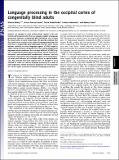Language processing in the occipital cortex of congenitally blind
Author(s)
Bedny, Marina; Pascual-Leone, Alvaro; Dodell-Feder, David; Fedorenko, Evelina G.; Saxe, Rebecca R.
DownloadBedney-2011-Mar-Language processing in the occipital cortex of congenitally blind adults.pdf (400.3Kb)
PUBLISHER_POLICY
Publisher Policy
Article is made available in accordance with the publisher's policy and may be subject to US copyright law. Please refer to the publisher's site for terms of use.
Terms of use
Metadata
Show full item recordAbstract
Humans are thought to have evolved brain regions in the left frontal and temporal cortex that are uniquely capable of language processing. However, congenitally blind individuals also activate the visual cortex in some verbal tasks. We provide evidence that this visual cortex activity in fact reflects language processing. We find that in congenitally blind individuals, the left visual cortex behaves similarly to classic language regions: (i) BOLD signal is higher during sentence comprehension than during linguistically degraded control conditions that are more difficult; (ii) BOLD signal is modulated by phonological information, lexical semantic information, and sentence-level combinatorial structure; and (iii) functional connectivity with language regions in the left prefrontal cortex and thalamus are increased relative to sighted individuals. We conclude that brain regions that are thought to have evolved for vision can take on language processing as a result of early experience. Innate microcircuit properties are not necessary for a brain region to become involved in language processing.
Date issued
2011-03Department
Massachusetts Institute of Technology. Department of Brain and Cognitive SciencesJournal
Proceedings of the National Academy of Sciences of the United States of America
Publisher
National Academy of Sciences (U.S.)
Citation
Bedny, M. et al. “Language processing in the occipital cortex of congenitally blind adults.” Proceedings of the National Academy of Sciences 108 (2011): 4429-4434. ©2011 by the National Academy of Sciences.
Version: Final published version
ISSN
1091-6490